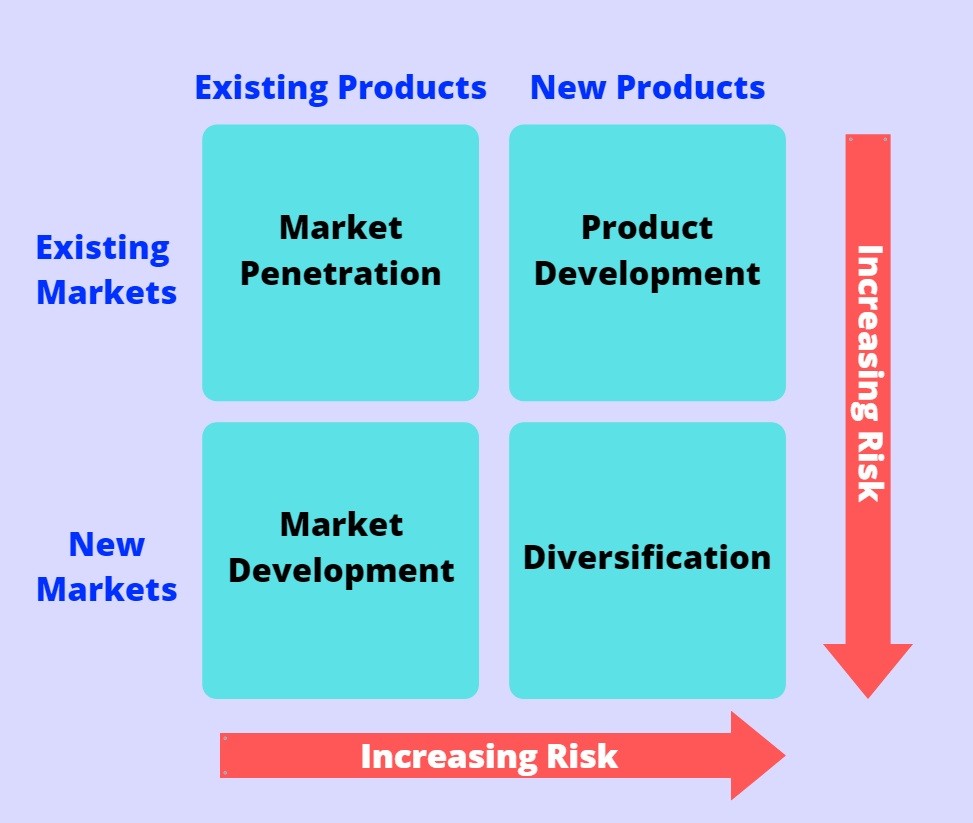Ansoff Matrix is the main tool used by organizations to evaluate their strategic growth and performance. This is also known as the Product/ Market expansion grid as it is used by the organizations to plan and analyze their growth strategies. This matrix talks about four strategies that can be used by any organization to analyze and evaluate each strategy.
H. Igor Ansoff, a business manager, and an applied mathematician introduced the Ansoff matrix in 1957. Since then, the Ansoff matrix helped many marketers, researchers, strategy planners, managers and many other stakeholders of the business to identify the strategies and the risks involved.
Ansoff Matrix explains four main strategies.
- Market Penetration
- Product development
- Market development
- Diversification

Market Penetration
In the strategy of Market penetration, the organizations are expecting to make use of the products that are already existing in the market. The organization is not going to introduce new products under this strategy, instead, they are trying to capture more market share using the existing products products.
Increasing the market share under market penetration can be achieved in few ways.
- Introducing and increasing promotions and discount schemes to promote the product more to the customers.
- Decrease the prices to attract existing customers and crate a repeat customer base as well as to attract new customers to the product.
- Acquiring a competitor who has exposure to the same market and obtain their customer base.
Product Development
This is a stage that involves a great deal of research and development. Under the product development strategy, the organization develops a new product aiming at the existing market. They do not concentrate on achieving a new market share but provide a new attitude through a new product in the existing market. Product development strategy is most suitable for organizations that have a strong understanding of their existing market and the customer and who are willing to be innovative and creative to provide a new product or service to the customers. This strategy is implemented to meet a currently unmet need of the existing customers and create a repeat customer base.
- Product development strategy can be conducted in many ways.Investing and conducting research and development programs to find unmet needs of the customers and to develop a new product to satisfy the identified unmet need.
- Creating strategic partnerships with the value adding organizations/ rivalry competitors
- Acquire competitor production process and combine that process with the organizational existing production process. This will help the organization to implement a new product with more features to satisfy the unmet customer needs.
Market Development
Under the market development strategy, the organization enters a new market with the existing products. This is not only concerned about increasing the market share, but this is also about starting the distribution to a new geographical area, new region or new customer segment that the organization has not catered before. Market development has a high possibility for success when the organization has the initial technology to take over new markets, the consumers in the new market segment are active and profitable.
Market development strategy can be implemented using the following ways.
- Introducing the product to a new customer segment
- Entering a new geographical market within the country
- Entering to international market
Diversification
In the diversification strategy, the organization is entering a new market with a new product. This can be considered as the riskiest strategy in the Ansoff matrix. Even though this can be considered as the riskiest, the risk can be mitigated by following the necessary steps.
Diversification can be divided in to two main components.
- Related Diversification – There are potential synergies to be realized between the existing market and the new product.
- Unrelated Diversification – There are no potential synergies to be realized between the existing market and the new product.
Related articles
What is Strategic Management?
03 Branches of strategy

